Some of your questions:
- 01 What material are the parts made of?
- 02 What are the characteristics of Fibreglass parts?
- 03 Do you have the parts in stock?
- 04 Are the parts offered original spare parts?
- 05 Are the parts supplied with any type of approval certificate?
- 06 What is included?
- 07 Are the parts or kits painted with primer?
- 08 What is the manufacturing lead time?
- 09 Will I have to cut off sheet metal from the original fenders or wings?
- 10 Are the wide rear quarter panels mounted on top of the original fenders or instead of the original ones?
- 11 Are the fibreglass parts supplied with the standard fixing clips or brackets?
- 12 What are the fibreglass pieces glued with?
- 13 How are the fibre parts glued together?
- 14 Do I have to homologate a wide body kit?
- 15 In the case of spacers, do they have to be approved?
- 16 How much does it cost to homologate a track width change and a wide body kit?
- 17 Any advice on assembly and painting?
- 18 Are there any specific instructions I should give to my installer?
- 19 Do the body kits come pre-drilled?
- 20 Will my new body kit fit perfectly?
- 21 Will the installer have to make any modifications to my car for the body kit to fit?
- 22 What happens if I receive the item with small cracks, scuffs or scratches?
- 23 What happens if I receive an item that has been significantly damaged?
- 24 How long will it take for your item to arrive?
- 25 How can I get assistance for an article that is not as expected?
- 26 How do I pay for the items?
- 27 Fitting conditions of the parts:
- 28 Terms and conditions of delivery Online sale:
- 29 What are the General Terms and Conditions?
- 30 LOPD and LSSI Legal Notice
Q 01 What material are the parts made of?
All parts are made of Glass-Fiber Reinforced Plastic (GFRP) unless otherwise stated.
GFRP is a composite material consisting of a plastic or resin matrix reinforced with glass fibres. It is a light, resistant and easy to mould material, which is widely used to make complex and curved shapes. It is widely used in the nautical, aeronautical and automotive industries, among many others.
It is colloquially referred to as Fibreglass or Polyester Fibre.
WE DO NOT MANUFACTURE Carbon Fibre for several reasons, the first being that it requires 100 % dust-free facilities, which is difficult to achieve in the heat of cutting and sanding a huge number of Fibreglass parts.
We also prefer not to cheat our customers, as if the Carbon parts are not pressurised in an very expensive autoclave, they will not achieve superior strength.
We also dislike seeing cars, made by "supposed Carbon specialists", full of small air bubbles (unaesthetic breakage points) or discoloured by the effect of the sun's ultraviolet rays (UV).
Therefore, if you are looking for superior strength, we can optionally manufacture your parts in a Carbon/Kevlar mix with a white or grey gel coat finish, which can be painted in the colour of the car.
These Carbon/Kevlar parts are made for strength, not aesthetics.
Q 02 What are the characteristics of Fibreglass parts?
For the correct installation of these body parts it is necessary to know the properties of GFRP. By purchasing these parts you accept that they may require minor adaptation/modification/cutting/heating to fit. Mounting kit and mounting instructions are not included. Additional equipment such as brake lights or fog lights/grilles/logos/stickers are not included unless otherwise stated in the description. Parts require professional assembly. Parts should be fitted on a trial basis before priming and painting to check fitment and any necessary modifications. Fibreglass parts are unfinished and must be prepared prior to priming (sanding/filling/priming/heated with a blower).
All Carbon/Kevlar panels have a white or grey gel coat finish, which is paintable. These Carbon/Kevlar, are made for strength, not aesthetics.
Even if you are familiar with the assembly process, we recommend watching the video: Tutorial typical assembly of fibreglass body kit which, although in English, clearly shows the assembly process with basic tools.
Q 03 Do you have the parts in stock?
Really, it is impossible to have parts in stock for all the models, of all makes, that have been in regular competition since the days of the Fiat 600 Abarth. Everything is made to order by hand, once payment has been received.
Q 04 Are the parts offered original spare parts?
NON ORIGINAL spare part primarily intended for use in motor racing.
Q 05 Are the parts supplied with any type of approval certificate?
As parts intended for motor racing, this is not necessary. Therefore, we do NOT provide ANY documents (except the invoice) with the parts, unless otherwise stated on the model page of the model you are interested in.
If, for your specific use or in your country, any approval is required, it shall be at your expense.
PARTICULAR CASE IN SPAIN:
Although the homologators may have the support of some of these certificates (for example TÜV) to make the technical project, what is important and obligatory in Spain is the technical project itself; since the TÜV certificates, strange as it may seem to you, ARE NOT VALID IN SPAIN.
It is absurd that you have to pay to have a product approved in another EU country, because the TÜV certificate is valid in almost all of Europe, except in Spain, which has different regulations. Then we will see how advantageous it is.
Anyway, that's the advantageous reason why typical body kits in Spain cost, for example, around 1.100 or 1.200 € and in Germany TÜV-approved body kits usually start at 4.000 €... up to 6 digit figures...
TÜV TEST REPORT:
Although we manufacture kits or parts for competition by default and always seek maximum lightness within the strength required for competition, we can supply them for "Road use" in countries where necessary, by applying an extra layer of material and/or increasing the thickness of the fibre layers. We can supply 300 x 300 mm test specimens for TÜV certification of the strength of the materials we use in our body kits.Enquire about price and configuration by email
TÜV TEST REPORT SAMPLE:
Test report
Applicant: Clasicos de Rally, S.L.
Receipt of test object: 02/05/2008
Test date: 08/05/2008 – 14/05/2008
1. Test report (findings)
1.1 Task
In accordance with the order, the GRP panels listed below were tested in accordance with DIN 52 306 and DIN 52 307.
1.2 Description of the test object
Manufacturer (resin):
Manufacturer (fibre mat)
Type/design: Thin layer, 3 x 450 g/m² glass mat
Resin:
Top layer (gel coat):
Hardener:
Accelerator: (4% cobalt)
Glass fibre mats: 3 x 450 g/m²
Method of manufacture: Hand lay-up process
Dimensions of test specimen [mm]: 300 x 300 x 3
1.3 Assessment of the material upon impact with a blunt object, according to DIN 52 306
Pre-treatment of test specimens: Four hours of storage at +40°C. Four hours of storage at +23°C
Test specimen: Ball for drop test
Mass of ball: 227 g
Diameter of the ball: 38 mm
Test conditions: The material sample was fixed in a clamping frame (according to DIN 52306, section 3.4). In accordance with the wall thickness of 3.0 mm, ball drop tests were carried out from a drop height of 9 m at +40°C and +23°C. The breakage drop height was not determined.
Ball drop height: 9 m
1.3.1 Test result
Note: No impact marks were produced during the ball drop test.
The test samples were not pierced.
The edges produced during the breakage test are sufficiently blunt.
1.4 Assessment of the material upon impact with a blunt object, according to DIN 52 307
Pre-treatment of test specimens: Four hours of storage at +40°C. Four hours of storage at +23°C.
Test specimen: Steel arrow for drop test
Diameter of steel arrow ball: 3,175 mm
Test conditions: The material sample was fixed in a clamping frame (according to DIN 52306, point 3.4).
In accordance with the wall thickness of 3.0 mm, ball drop tests were carried out from a drop height of 9 m at +40°C and +23°C. The fracture drop height was not determined.
Steel arrow drop height: 9 m
1.4.1 Test result
Note: No impact marks were produced during the arrow drop test.
The test samples were not pierced.
The edges produced during the break test are sufficiently blunt.
1.5 Appendices
None
1.6 Notes
The material specifications listed under point 1.2 refer exclusively to the data provided by the client.
2. Expert assessment (report)
Based on the findings, the tests carried out and their results, we consider the material sample presented to be suitable for use in the exterior of vehicles.
The requirements regarding splinter resistance and burning properties are met.
This test report comprises pages 1 to 4 and is only valid as a whole.
The test results and findings refer only to the test objects in question.
Vienna, 15 May 2008
TÜV AUSTRIA AUTOMOTIVE GMBH
Accredited by the Accreditation Body of the Federal Motor Transport Authority, Federal Republic of Germany
Q 06 What is included?
Grilles are not included, but some can be supplied on request.
Headlamps, tail lights and indicators not included.
Fibre parts and body kits are supplied unpainted.
Q 07 Are the parts or kits painted with primer?
Of course NOT.
Body kits are unfinished items and must be sanded and primed before painting.
Our body kits come with a Top Coat or Gel Coat (marine grade) coating from the factory, so they usually require less prep work before painting than other kits.
It is very usual for low quality manufacturers to turn "their problem" with quality into a sales argument by offering parts as primed and "ready to paint".
When they offer you a "ready-to-paint piece... start to tremble...".
This is because a primed piece usually hides materials of inferior quality and/or repairs due to problems of adherence and breakage of the moulds or the pieces themselves. This is solved by "smearing" the parts with filler. The problem is that this thick layer hides all kinds of quality problems and, also, the most beautiful part of a body, its lines and details.
A new and shiny mould will always produce a shiny piece, which is not suitable for painting and which will have to be sanded to remove all shiny areas. It will not be sanded with too much pressure, as the aim is simply to mattify the piece so that it will hold the paint.
Q 08 What is the manufacturing lead time?
It is variable, depending on several things: list of previous jobs, availability of the moulds of that model (sometimes very busy), etc. The best thing to do is to consult it at the time you are interested in placing the order.
Urgent orders from our customers, due to competition accidents (replacement of one or two pieces) we always try to serve them as quickly as possible.
Enquire by email
Q 09 Will I have to cut off sheet metal from the original fenders or wings?
Typically yes, as you will be fitting wheel arches because you intend to significantly increase the track width and this will cause the wheel to interfere with the fender.
Many customers of valuable cars keep the trimmed sheet metal arch in case they wish to reverse the process at some point in the future.
Q 10 Are the wide rear quarter panels mounted on top of the original fenders or instead of the original ones?
Front:
In modern cars they are usually screwed on, just like the original ones, after removal.
The wheel arches are normally glued with Polyurethane, but there are models that are prepared to be screwed on.
Rear:
Several types of assemblies are possible.
The ideal for competition, where the greatest lightness is desired, is to replace the entire sheet metal quarter panel with the fibreglass quarter panel. We recommend see this video on the correct way to do it, with the difference that in our case the rear quarter panel cannot be welded like the sheet metal, and will have to be glued with structural adhesive (epoxy or polyurethane).
In some cases it may be appropriate the partial section replacement of the rear quarter panel by gluing, after making use of the flanging tool to prepare a "step" and facilitate the gluing of the fibre part.
See: How to make complex overlapping.
See: How to grind welding spots.
See: Pneumatic overlapping machine.
See: Manual overlapping machine.
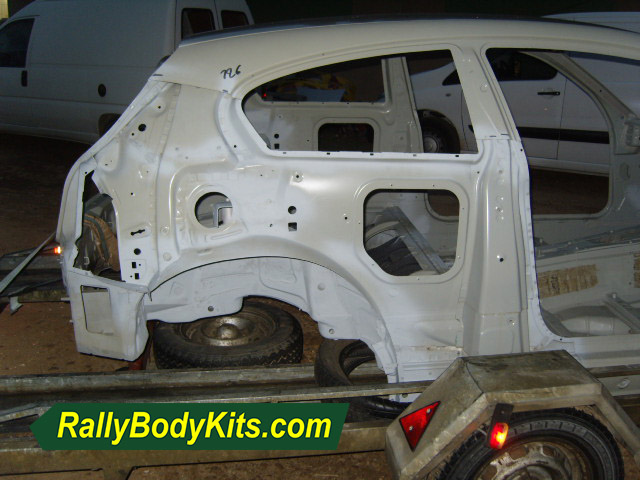
Rear quarter panel preparation BMW 1 Series Maxi Photo 1
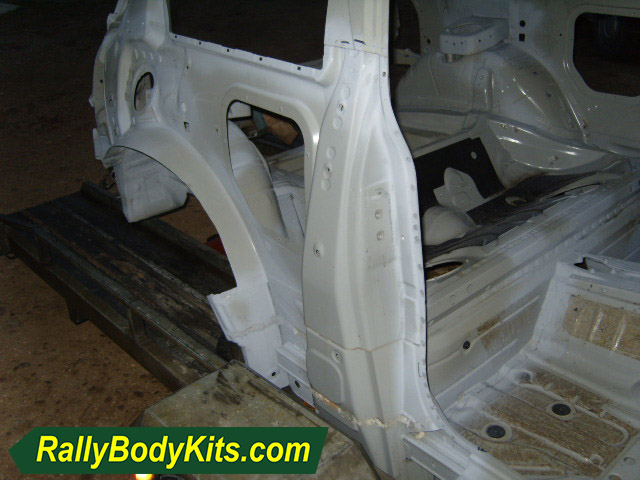
Rear quarter panel preparation BMW 1 Series Maxi Photo 2
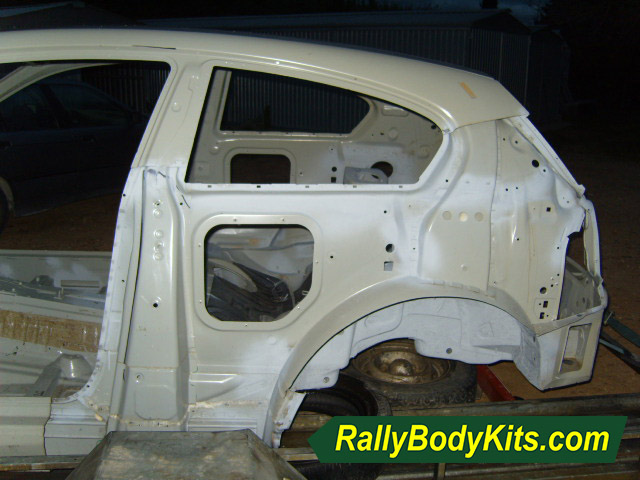
Rear quarter panel preparation BMW 1 Series Maxi Photo 3
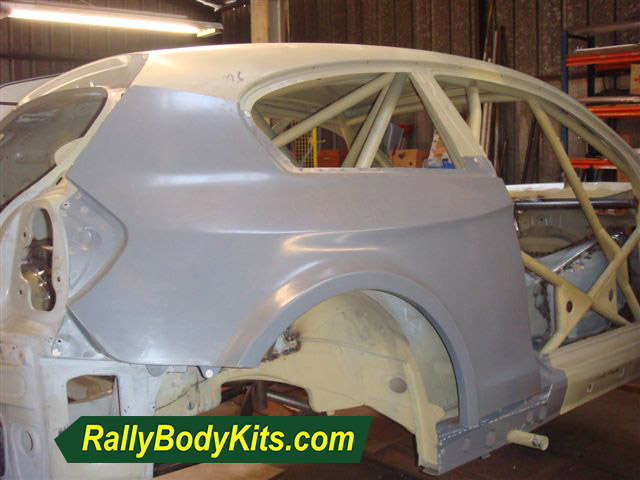
Rear quarter panel preparation BMW 1 Series Maxi Photo 4
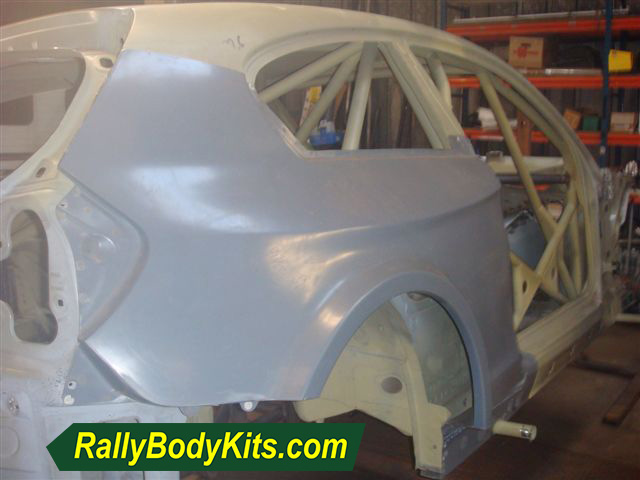
Rear quarter panel preparation BMW 1 Series Maxi Photo 5
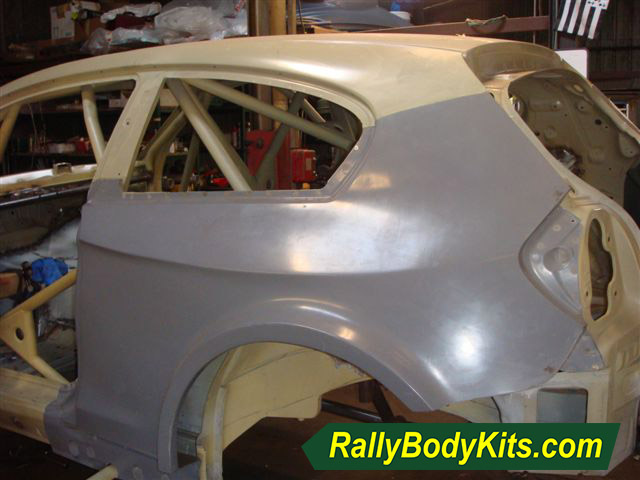
Rear quarter panel preparation BMW 1 Series Maxi Photo 6
Q 11 Are the fibreglass parts supplied with the standard fixing clips or brackets?
Although the fibreglass parts reproduce with total fidelity the exterior of the original parts, with their holes for the original screws (marked for drilling at convenience) or recesses for the original clips, for technical reasons, it is not possible to do the same (at least at reasonable cost) on the interior parts.
Therefore, when possible, the fixing can be by screwing the same as on the standard parts (usual on the front wings), but -in general- we recommend gluing them (see next point).
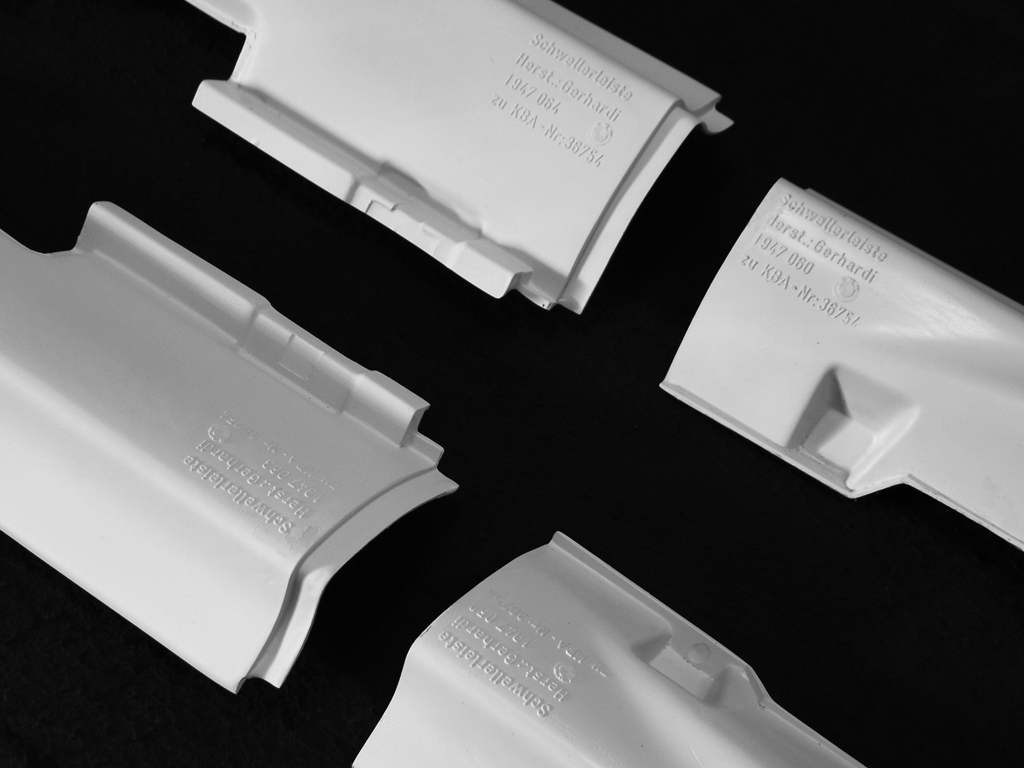 BMW E30 Look 318is side skirts detail
BMW E30 Look 318is side skirts detail
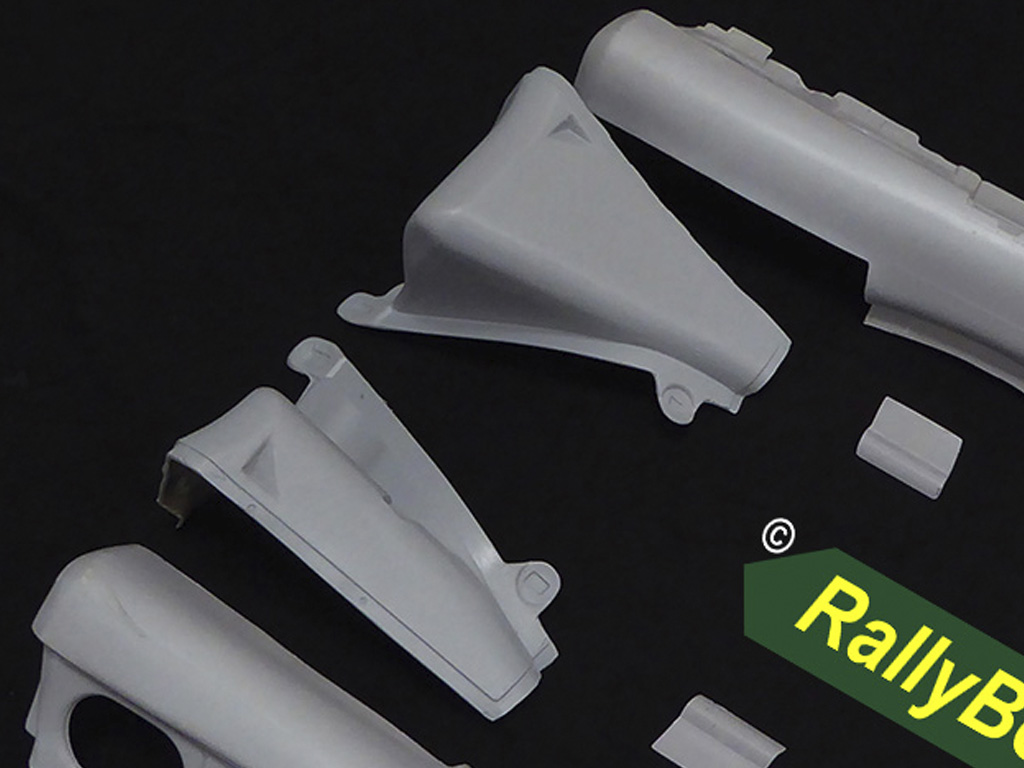 Mercedes 190 W201 16v Cosworth side skirts detail
Mercedes 190 W201 16v Cosworth side skirts detail
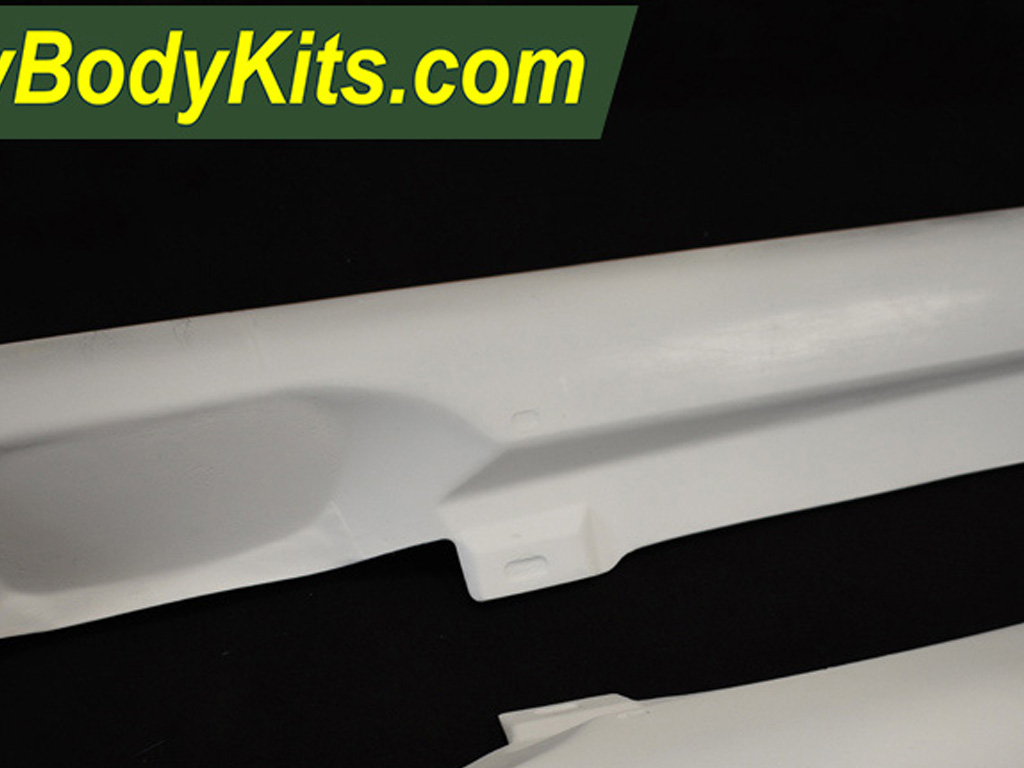 Seat Leon Cupra R Mk1 side skirts detail
Seat Leon Cupra R Mk1 side skirts detail
Q 12 What are the fibreglass pieces glued with?
Although there are various systems (e.g. with Epoxy), the simplest (without catalyst) and most economical way is to use fast curing one-component Polyurethane glass adhesives (e.g. 3M 08613). And we all know how difficult it is to peel off a windscreen glued with them, as once hardened they provide structural strength to the parts.
It is the same material, but less viscous (allowing it to be applied with a manual silicone gun), than the one used by automotive glass workshops, which is much denser (requiring pneumatic guns, as it is so accelerated) because when a windscreen is replaced we may have to continue our travel in 60 minutes, even if it is raining...
It is black in colour, but once it has dried and hardened, it can be painted.
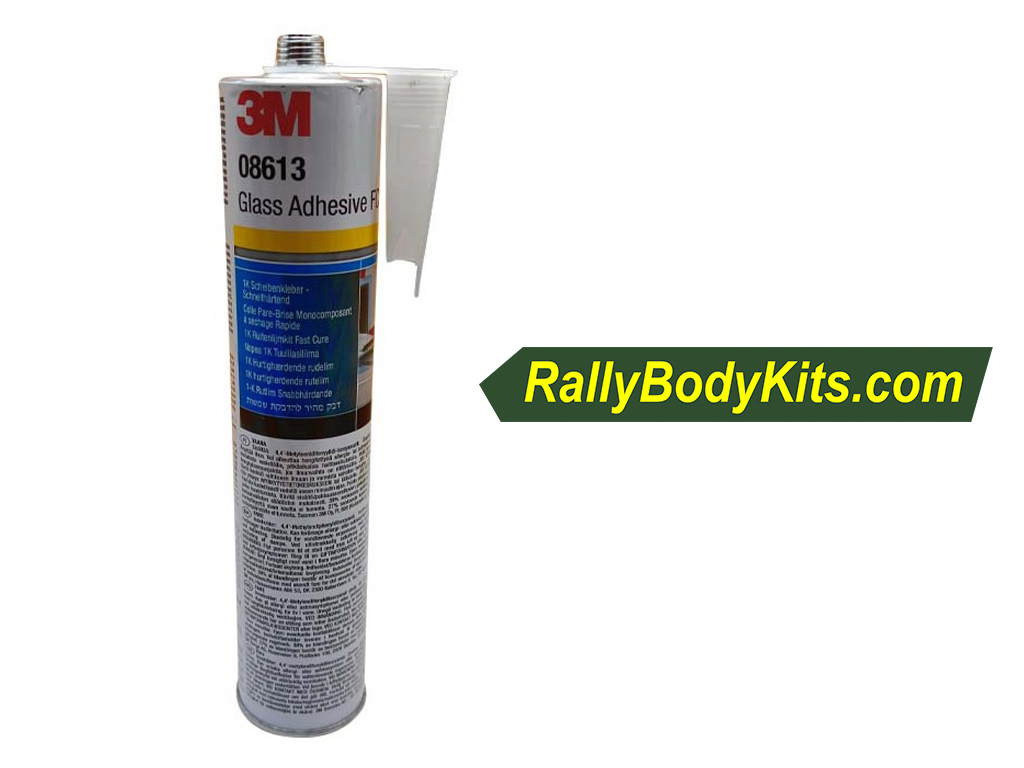
Q 13 How are the fibre parts glued together?
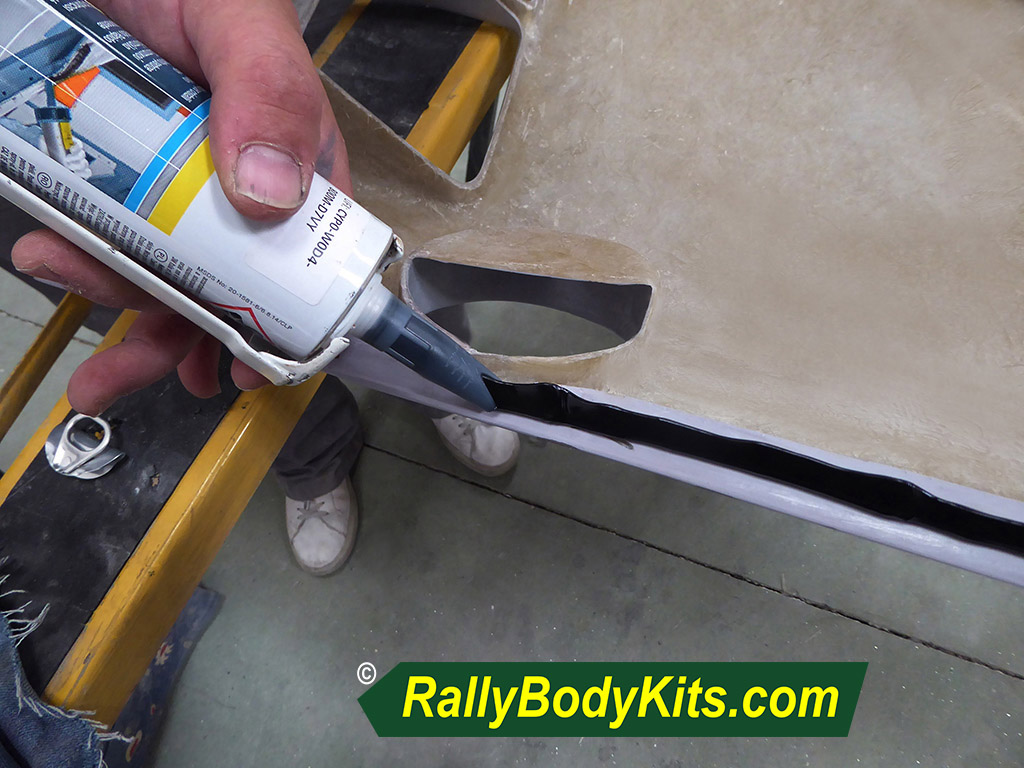 After decontaminating from grease, oil, wax, silicone, dust, etc. apply the Polyurethane by holding the applicator vertically (at 90° to the surface) and dispensing the adhesive with a continuous inverted V-shaped movement (note the shape of the nozzle).
After decontaminating from grease, oil, wax, silicone, dust, etc. apply the Polyurethane by holding the applicator vertically (at 90° to the surface) and dispensing the adhesive with a continuous inverted V-shaped movement (note the shape of the nozzle).
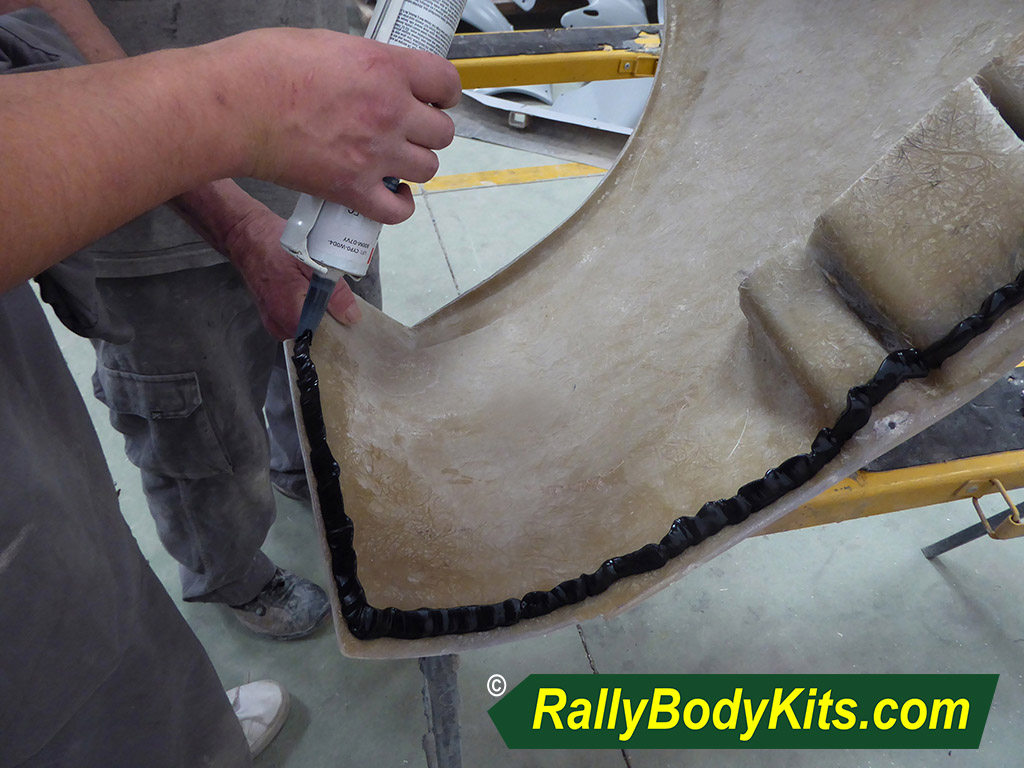 A triangle or V-shaped bead has superior penetration into the surface to be glued and prevents air bubbles.
A triangle or V-shaped bead has superior penetration into the surface to be glued and prevents air bubbles.
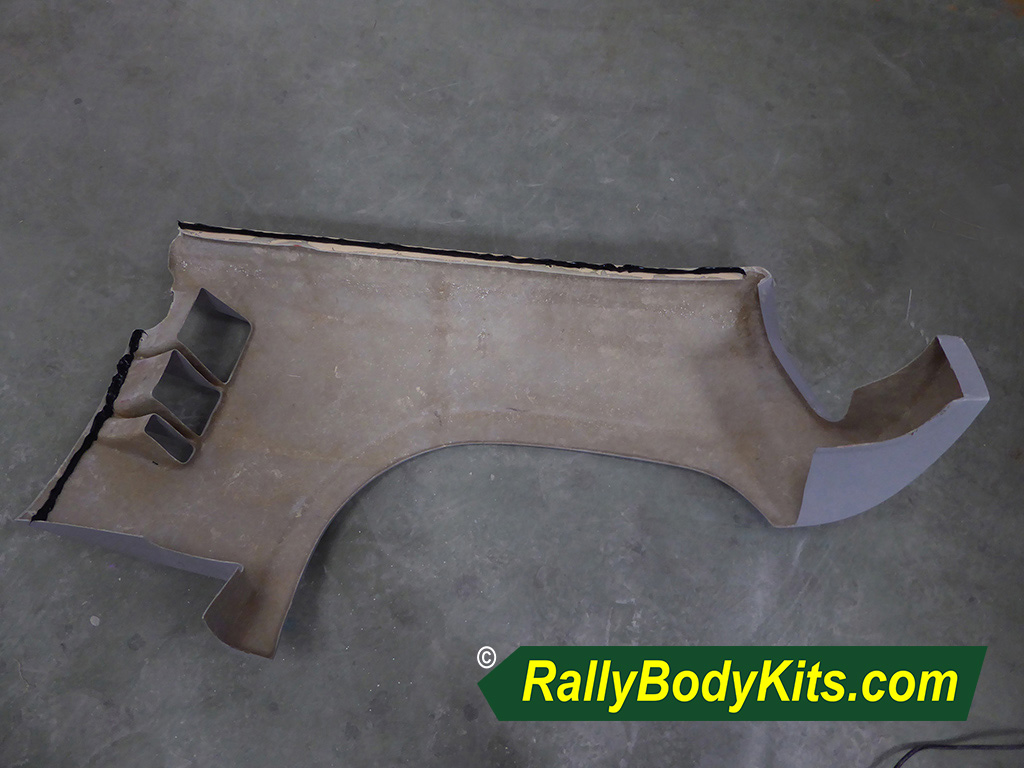 The result should be a uniform bead. Add material if it is not.
The result should be a uniform bead. Add material if it is not.
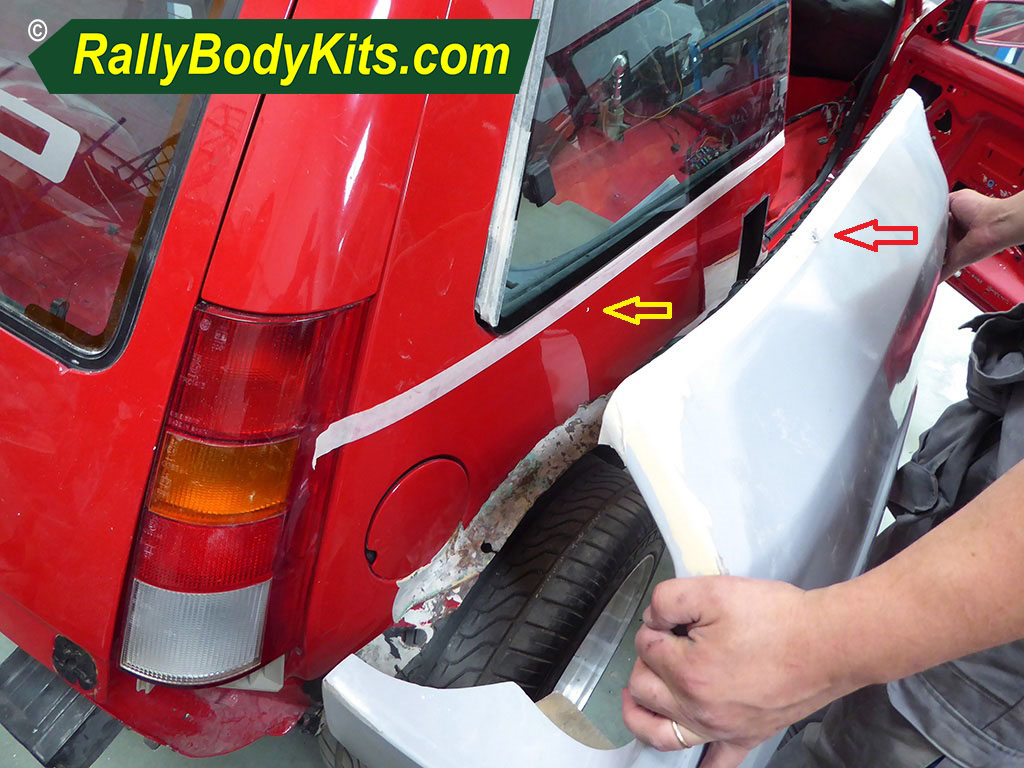 Before applying the Polyurethane, the fit of the part must be checked, seated and/or retouched.
Before applying the Polyurethane, the fit of the part must be checked, seated and/or retouched.
Small temporary screws will help to hold the part in place until the hardening process is complete.
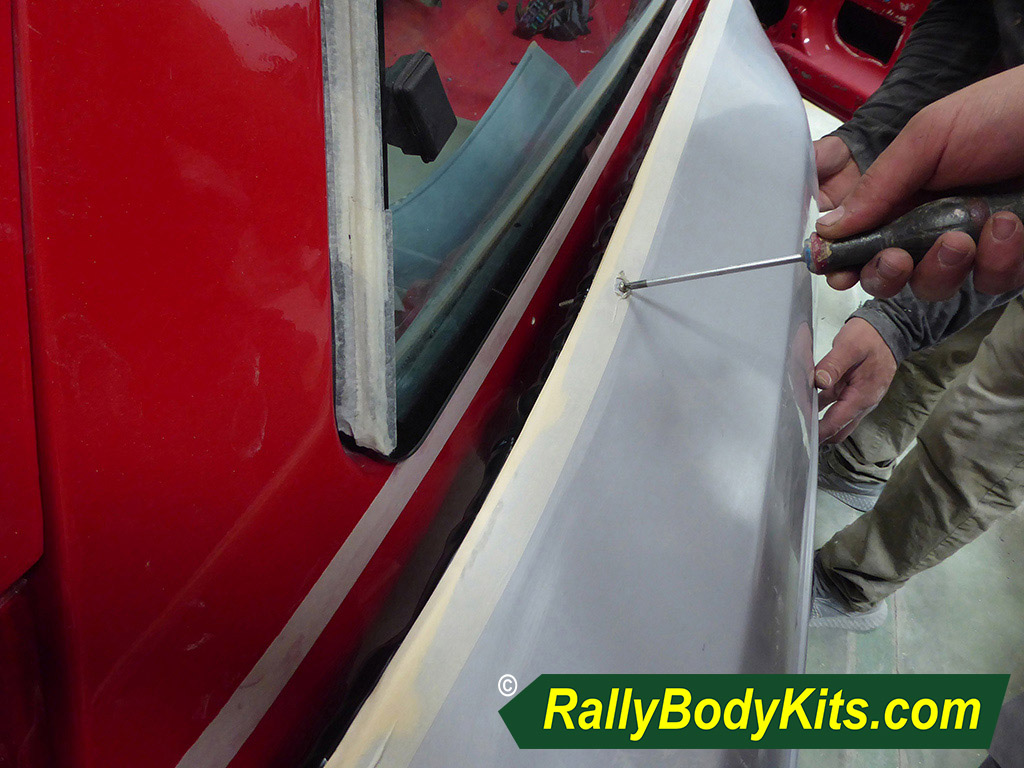 Surfaces to be cleaned of Polyurethane must have been protected with masking tape.
Surfaces to be cleaned of Polyurethane must have been protected with masking tape.
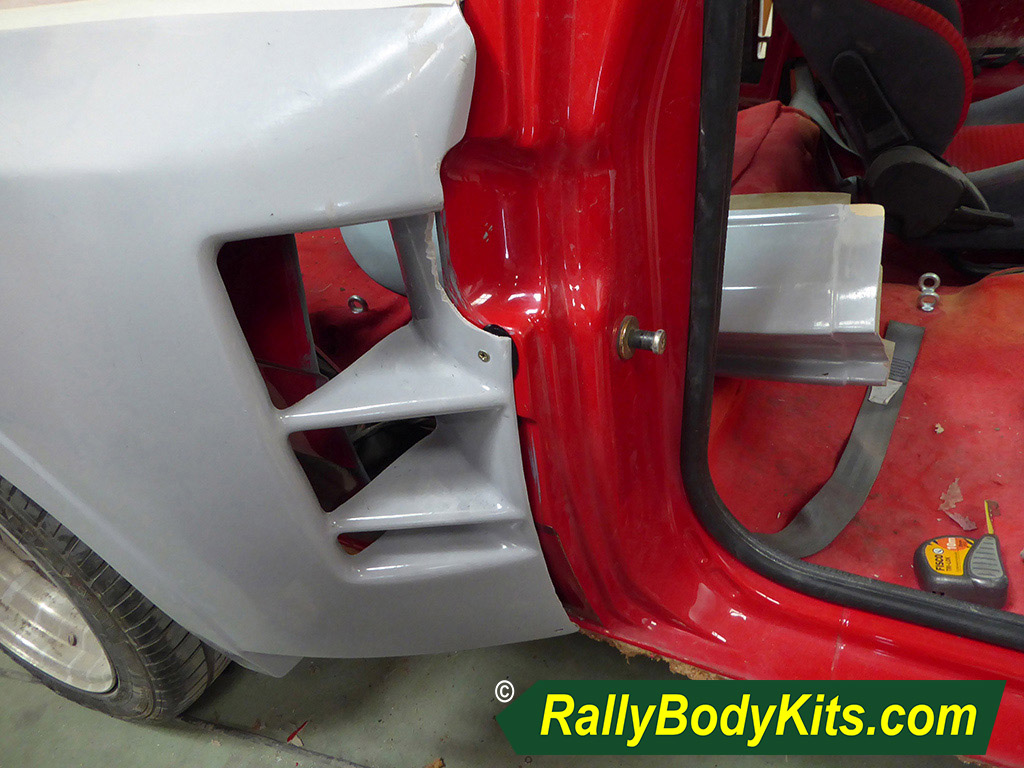 Screw in the temporary screws with moderation, without crushing the part or expelling all the Polyurethane.
Screw in the temporary screws with moderation, without crushing the part or expelling all the Polyurethane.
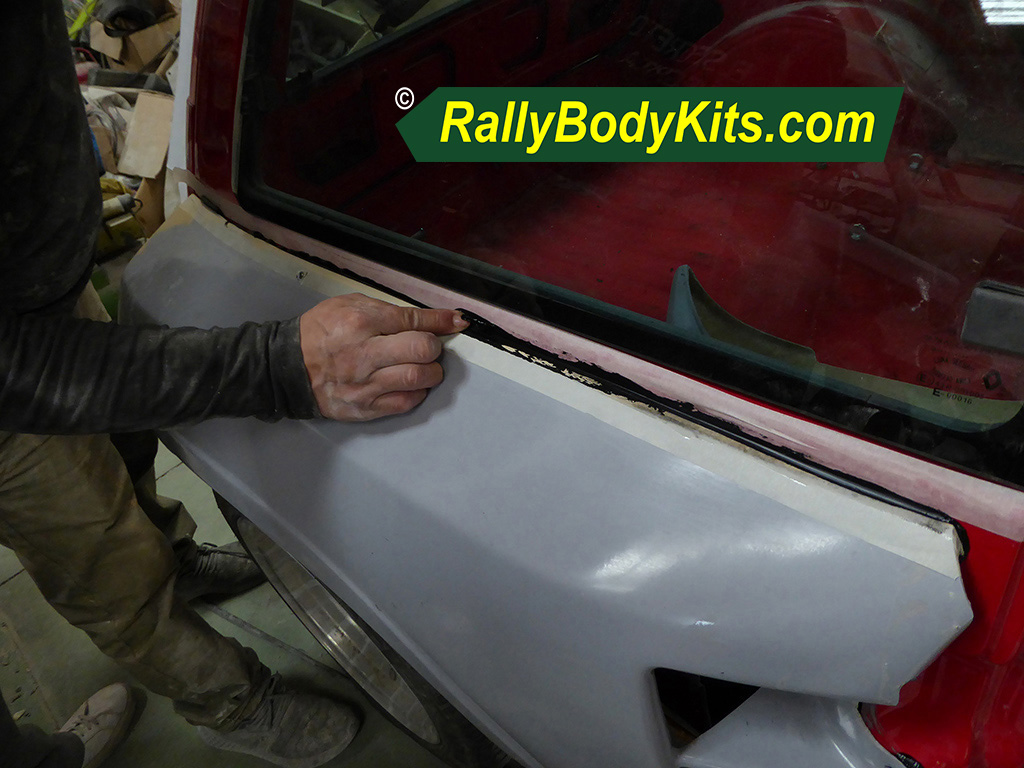 It's dirty, but with your finger (and the feel it brings) it's the best way to make the finish bead.
It's dirty, but with your finger (and the feel it brings) it's the best way to make the finish bead.
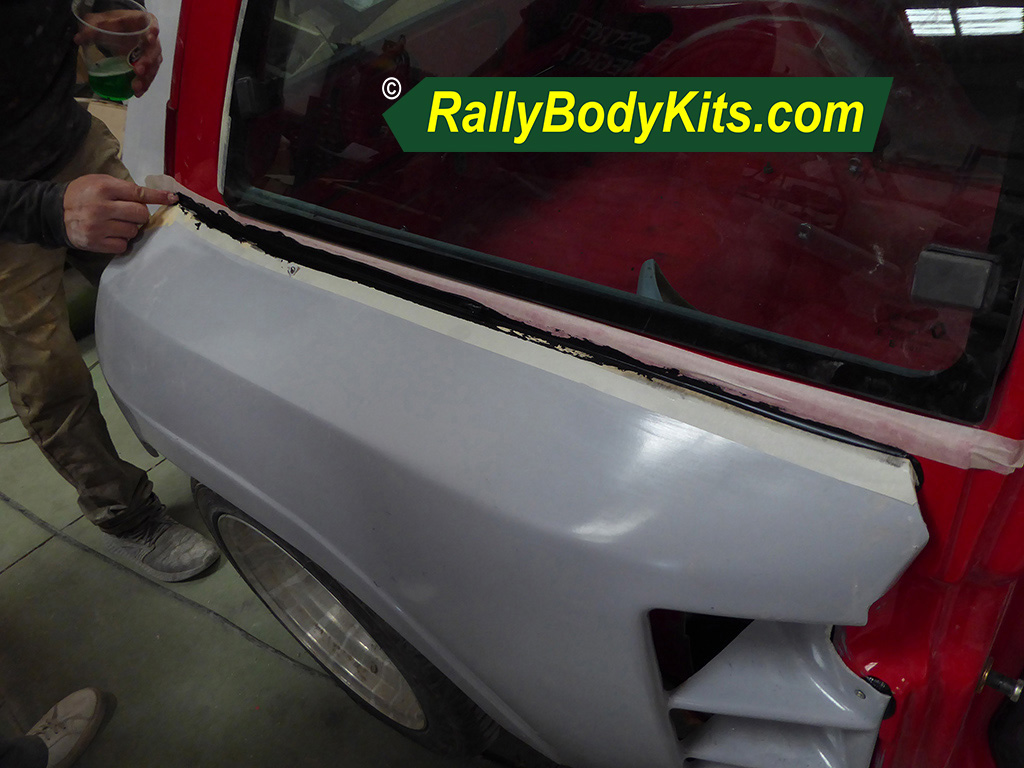 Use soapy water to keep soiling to a minimum (note the glass very close at hand).
Use soapy water to keep soiling to a minimum (note the glass very close at hand).
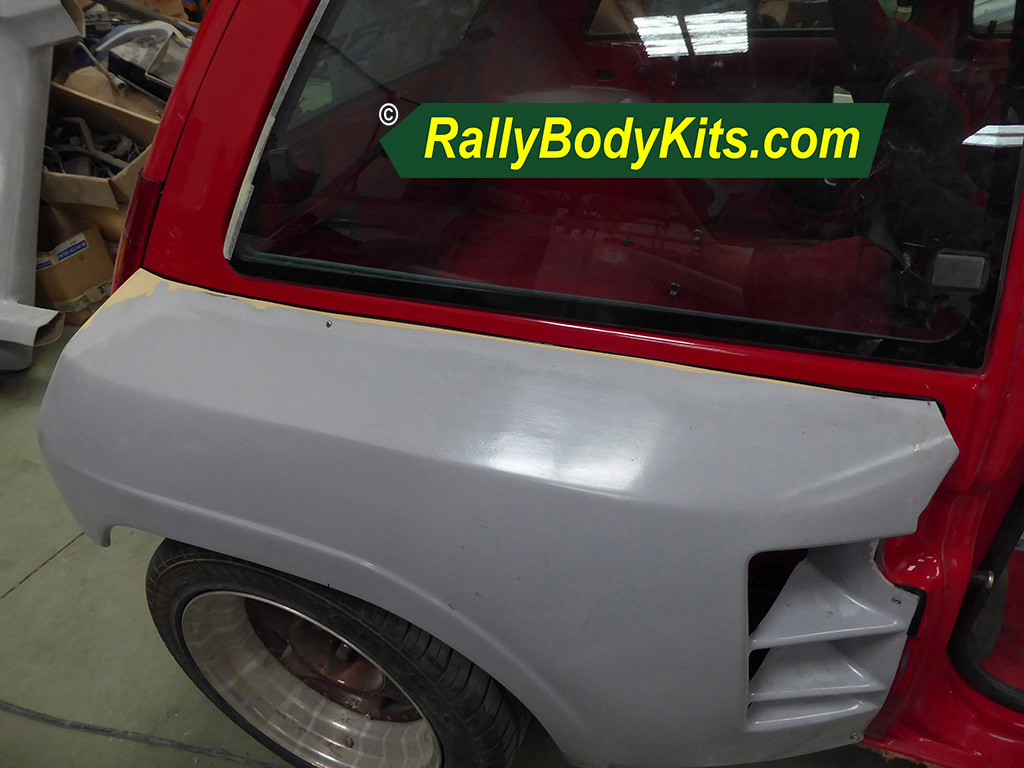 After removing the masking tape, you can achieve a perfect finish.
After removing the masking tape, you can achieve a perfect finish.
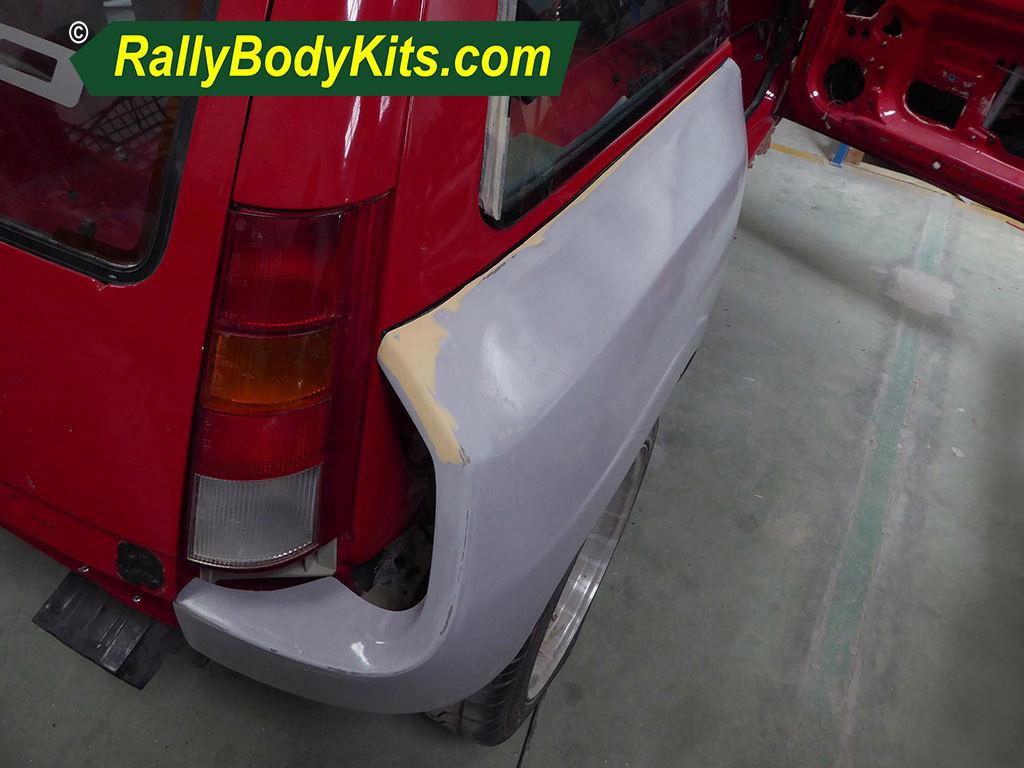 Once hardened, you can remove the temporary screws and paint even the Polyurethane itself.
Once hardened, you can remove the temporary screws and paint even the Polyurethane itself.
For the unbelievers: The union is "bomb-proof"
Q 14 Do I have to homologate a wide body kit?
Realmente, lo que tiene que homologar es el cambio de ancho de vías (la distancia que hay entre los centros de los neumáticos de cada eje y que es un dato que aparece reflejado en la ficha técnica de cada vehículo), con las llantas de su elección y SIN SEPARADORES, SÓLO si se modifica más del margen legal (en España 60 mm en turismos y 150 mm en vehículos todoterreno). Evidentemente nadie pone un kit de carrocería para dejar las ruedas "metidas" en la posición de origen.
En el caso de que al aumentar el ancho de vías, los neumáticos sobresalgan de la carrocería, será necesario instalar aletines o algún elemento que proteja a los demás usuarios de la carretera de las proyecciones de piedras, barro, nieve y agua, y reduzcan para dichos usuarios el riesgo de contacto con las ruedas en movimiento.
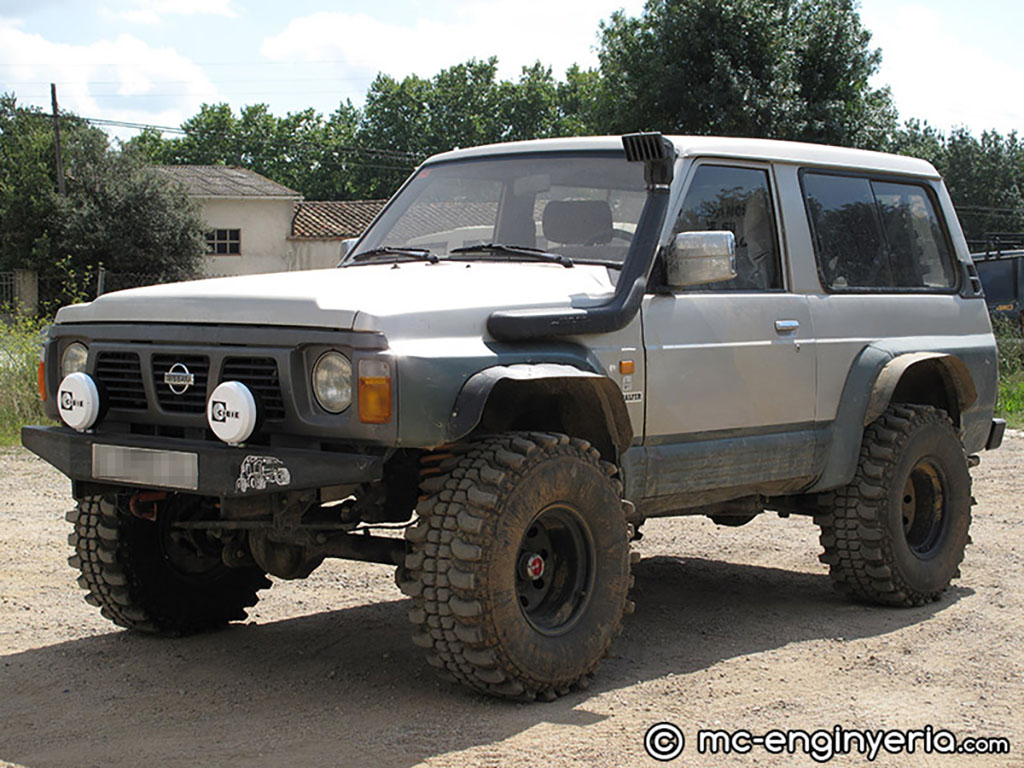
Un claro ejemplo en el que las faldillas no es lo que hay que homologar en principio.
Por tanto, si cambiamos el ancho de vías (SIN SEPARADORES) sólo cambiando el ET de las llantas, hasta el mencionado margen legal, no será necesaria homologación.
Ver: MANUAL DE REFORMAS DE VEHÍCULOS - REVISIÓN 7ª - 01/11/2022
Q 15 In the case of spacers, do they have to be approved?
Sea cual sea nuestro caso, por ser un elemento interpuesto entre el buje y la llanta, montar separadores se considera SIEMPRE una reforma, da igual la medida de estos, que varíen el ancho de las vías o no.
Según su medida (si no exceden de 60 mm en turismos y 150 mm en vehículos todoterreno) no será necesario un proyecto técnico, lo que reduce mucho el costo de la homologación.
Ver: El caso de los separadores ¿Hay que homologarlos?
Ver: ¿Como comprueban en ITV el ancho de vías?
Ver: ¿Los separadores de llantas pasan la ITV sin homologar? ¡Duda resuelta!
Q 16 How much does it cost to homologate a track width change and a wide body kit?
Ver un caso típico: ¿Cuánto cuesta homologar un cambio de vías y un kit ancho de carrocería?Q 17 Any advice on assembly and painting?
Se recomienda la instalación por un profesional.
Recomendamos encarecidamente que cualquier producto de carrocería sea instalado profesionalmente por un taller de carrocería con experiencia en la instalación de kits de carrocería.
TODOS LOS PRODUCTOS NECESITAN CIERTO TRABAJO DE PREPARACIÓN. NO DEJE QUE UN TALLER ESTÁNDAR INSTALE SUS PIEZAS DE FIBRA DE VIDRIO, SIEMPRE NOS CULPARÁN DE SUS PROBLEMAS.
Su taller de carrocería debe probar el montaje de todos los paneles de la carrocería en el vehículo ANTES de lijar, taladrar, rellenar, cortar, pintar o modificar las piezas de alguna manera.
Si nunca ha montado un kit de carrocería de fibra de vidrio, debería ver el video tutorial de la barra de la derecha.
Podemos encargarnos de montar y pintar las piezas que ofertamos.
Nuestro taller está en La Coruña. ¡Precio competitivo!
Q 18 Are there any specific instructions I should give to my installer?
Un taller de carrocería bien cualificado no debería tener problemas para instalar nuestro kit de carrocería.
Debería decirles que deben de probar el montaje de todas las piezas antes de modificarlas o prepararlas, ya que los kits de carrocería no se pueden devolver si se modifican de alguna manera.
Q 19 Do the body kits come pre-drilled?
Los kits de carrocería no son artículos "atornillados".
Están diseñados para ser adaptados al vehículo por un instalador profesional.
Su taller de carrocería probará el kit de carrocería en su coche y luego hará muescas, cortará o perforará el kit para que se adapte a su coche correctamente.
Q 20 Will my new body kit fit perfectly?
Sí, si lo instala en un taller de confianza con experiencia en la instalación de kits de carrocería o, simplemente, en uno que haga este tipo de trabajos con "cariño" y profesionalidad.
Un kit de carrocería de 700 euros no se ajustará tan perfectamente como un kit de carrocería de 3.000 euros, pero un instalador cualificado no tendrá ningún problema en hacer que se ajuste y se vea lo mejor posible.
Q 21 Will the installer have to make any modifications to my car for the body kit to fit?
Esto depende del kit de carrocería.
Algunos kits incluyen labios delanteros y traseros o complementos para el parachoques que no requieren ninguna modificación más que la perforación de agujeros en los puntos de montaje.
Algunos kits con parachoques completos simplemente reemplazan sus parachoques de fábrica, y algunos kits requieren la modificación o la eliminación de los soportes del parachoques.
Q 22 What happens if I receive the item with small cracks, scuffs or scratches?
Aquí en RallyBodyKits, tenemos que hacer que usted (el cliente), sea consciente de que si usted está comprando un artículo de carrocería de fibra de vidrio no podemos consentir el rechazo, las devoluciones o los cargos adicionales del taller por pequeñas grietas, rasguños o arañazos.
La fibra de vidrio es un material delicado y muy flexible antes de ser fijado en el vehículo.
El tránsito desde nuestras instalaciones a las de nuestros clientes puede dar lugar a problemas menores, pero usted debe aceptar esto antes de comprar cualquier artículo.
Q 23 What happens if I receive an item that has been significantly damaged?
En el caso de que un artículo haya sido dañado de forma importante durante el transporte, RallyBodyKits cooperará con usted en su totalidad para reembolsar o reemplazar el artículo, siempre y cuando se hayan respetado las condiciones de entrega y recepción del transportista.
Q 24 How long will it take for your item to arrive?
Normalmente se envía por: Dachser (envíos voluminosos a Europa), DHL (envíos medios a todo el mundo) o FedEx marítimo (envíos voluminosos a todo el mundo) al puerto de contenedores más cercano a su dirección (Incoterm CFR).
Enviamos accesorios a todo el Mundo. El tiempo de entrega internacional depende del país, del medio de transporte y del despacho de aduanas.
Las mercancías a Europa sólo a través de Dachser y usted nos puede solicitar el número de seguimiento (Número Único de Dachser).
RallyBodyKits pide a todos los clientes que se pongan en contacto con nosotros por correo electrónico o por teléfono (+34 661 24 14 14) antes de pagar cualquier pedido en línea. Le pedimos que haga esto para que pueda comprobar primero el plazo de fabricación en ese momento concreto.
Los artículos son todos bajo pedido y se fabrican por encargo.
Debe pagar el artículo por adelantado. Una vez recibido el pago en nuestra cuenta, pasamos el pedido a Producción.
Q 25 How can I get assistance for an article that is not as expected?
Intentamos ser meticulosos y ofrecer el máximo de fotos y descripciones detalladas de las piezas para su conocimiento, pero no siempre (especialmente con piezas poco frecuentes) es posible conocerlo todo, de todas las piezas, para todos los modelos, de todas las marcas, que han competido desde la época del Fiat 600. Especialmente en los casos de adaptaciones en otros modelos.
En ese caso lo mejor es una llamada de teléfono (en español) o un Email (en Español, English, Português, Français, Italiano) para buscar la mejor solución.
Q 26 How do I pay for the items?
Normalmente por transferencia bancaria. Se indicarán todos los datos bancarios en el presupuesto and in the accompanying email.
Consultar otras posibilidades.
Q 27 Fitting conditions of the parts:
En el caso de que un artículo no se ajuste correctamente o esté dañado, necesitaremos pruebas fotográficas para mostrar el problema. Puede enviarlas por correo electrónico o por correo postal. Una vez recibidas las pruebas, podremos decidir sobre el reembolso o la sustitución.
Por favor, asegúrese de que se comprueba el ajuste de todas las piezas antes de que cualquier trabajo se lleve a cabo. Si se lleva a cabo cualquier trabajo en cualquier artículo, por ejemplo, lijado, aparejado, ya no podemos aceptar estas mercancías para su reembolso o reemplazo.
Todos los artículos tienen que ser devueltos en el estado original en que fueron enviados (incluido embalaje).
Es muy importante que se compruebe el ajuste de todos los artículos ANTES de realizar cualquier trabajo.
Tenga en cuenta que algunos artículos pueden necesitar una ligera modificación para adaptarse a su coche y recomendamos que todos los artículos de carrocería, vendidos por nosotros, sean instalados por un taller profesional.
Sólo podemos aceptar la palabra de un taller profesional para los problemas de ajuste. Cualquier artículo que no sea llevado a un taller, no será considerado para su devolución o reemplazo.
Q 28 Terms and conditions of delivery Online sale:
Entrega a nivel de calle en las mercancías voluminosas.
En todos los artículos de Venta Online que haya recibido de nuestras instalaciones o de las de nuestros proveedores, insistimos en que se compruebe que todos los artículos no estén dañados antes de firmar el albarán del transportista.
Si encuentra algún bulto o producto dañado en el momento de la entrega, se debe informar al conductor y dejar constancia de los daños en la hoja de firmas de la entrega.
Si la mercancía es entregada dañada por el mensajero, y no se registra el daño delante del conductor, entonces RallyBodyKits no puede determinar si el cliente/la empresa de transporte es responsable del daño.
Como excepción, y no como norma general, Dachser da un plazo de SÓLO 24 horas, para reclamar por daños en un paquete no abierto en el momento de la entrega.
La mercancía sólo nos puede ser devuelta en condiciones de reventa.
El cliente tiene la obligación de cuidar las piezas una vez que las tenga en su poder y no se podrá devolver ninguna pieza que haya sido modificada, es decir, lijada, aparejada o pintada.
Esto es así ya que las piezas no serían reutilizables.
RallyBodyKits también insiste en que usted NO reserve ningún tiempo fuera del trabajo para aceptar la entrega de cualquier mercancía pedida a nuestra empresa o reservar vez para su coche en un garaje / taller para el trabajo en relación con los artículos pedidos.
Aunque RallyBodyKits ofrece un servicio de transporte al mejor precio para todos los artículos vendidos, no podemos, y no seremos responsables de que las compañías de transporte cometan errores, problemas en las rutas y las mercancías no lleguen a tiempo.
Q 29 What are the General Terms and Conditions?
Ver completos los General Terms and Conditions
Q 30 LOPD and LSSI Legal Notice
Ver el LOPD and LSSI Legal Notice
